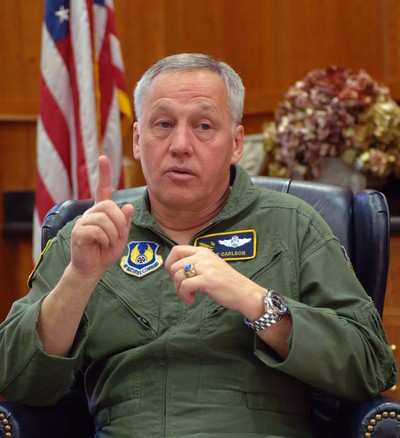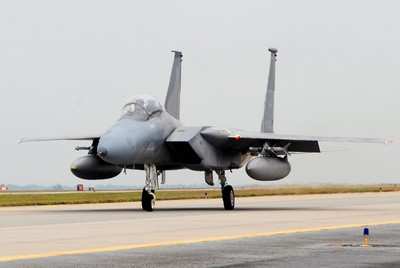Says 'Procurement Holiday' Must End To Maintain Readiness
The commander of Air Force Materiel Command, which is
responsible for delivering war-winning capabilities to the rest of
the Air Force, said during a recent visit to Air University at
Alabama's Maxwell Air Force Base that Air Force officials must
develop and buy new aircraft or risk the service becoming
irrelevant.

The Air Force must be careful not to be outclassed in the next
war, said Gen. Bruce Carlson (above) shortly after speaking with
Air War College and Squadron Officer School students February 27
about the importance of recapitalizing the Air Force's aging fleet
to maintain air dominance.
 "Soon we could be flying against
aircraft and air defense systems that our older aircraft were not
intended to fly against," Carlson said. "And if we don't have the
freedom to operate in hostile territories, we risk fighting the
next conflict on our home territory."
"Soon we could be flying against
aircraft and air defense systems that our older aircraft were not
intended to fly against," Carlson said. "And if we don't have the
freedom to operate in hostile territories, we risk fighting the
next conflict on our home territory."
The recapitalization crisis Air Force leaders see today is a
side effect of the United States winning the Cold War, the General
said. After the fall of the Soviet Union in 1991, the United States
took on the title of the world's only remaining superpower. As a
result, national priorities shifted away from defense projects.
"The decision was made to reduce the defense budget for more
domestic priorities because there was no longer a threat," the
general explained. "This is when we went on what has been called a
'procurement holiday.'"
Unlike Army and Marine Corps assets that were able to
reconstitute after Operation Desert Storm in 1991, Carlson said the
Air Force has remained in an almost constant state of "war" for
more than 17 years.
Leading up to Operation Iraqi Freedom in 2003, Air Force
aircraft were charged with enforcing the no-fly zones in Iraq for
more than a decade as part of operations Northern and Southern
Watch. Additionally, Air Force aircraft also spearheaded NATO's
strategic bombing campaign against the Serbian government in the
Balkans in the late 1990s.
In recent years, Carlson said, required maintenance on the F-15
Eagle has skyrocketed to 600-700 hours more than official
estimates. As ANN reported last
November, one of the older F-15 models assigned to the
Missouri Air National Guard broke in half during a routine training
mission... prompting the Air Force to ground the entire F-15 fleet
for several weeks.
"We're getting into unknown territory because we've been flying
airframes longer than expected," Carlson said. "We didn't build
these aircraft to last this long, and we didn't expect to see
corrosion of this magnitude. The F-15 is expected to remain in
service until it's more than 40 years old. At this rate,
maintenance costs are going to kill us."
In an Associated Press report last week, one senior Air Force
official talked about the serious effects caused by the high
operations tempo and G-force stress on older fighters. Gen. John
Corley, Air Combat Command commander, said flight hours on aircraft
like the F-15 could be compared to "dog years."
As China continues to modernize its military forces and Russian
aircraft continue to test American responses near Alaska and Japan,
the Air Force is at a critical point in maintaining air, space and
cyberspace dominance, Carlson said.

"There are others out there who are trying to build up their
airpower so they can exert their will over us," he said.
(Aero-News thanks Staff Sgt. Jason Lake, Air University
Public Affairs)
 NTSB Final Report: Rutan Long-EZ
NTSB Final Report: Rutan Long-EZ ANN FAQ: Turn On Post Notifications
ANN FAQ: Turn On Post Notifications Classic Aero-TV: ICAS Perspectives - Advice for New Air Show Performers
Classic Aero-TV: ICAS Perspectives - Advice for New Air Show Performers ANN's Daily Aero-Linx (06.28.25)
ANN's Daily Aero-Linx (06.28.25) Aero-News: Quote of the Day (06.28.25)
Aero-News: Quote of the Day (06.28.25)





